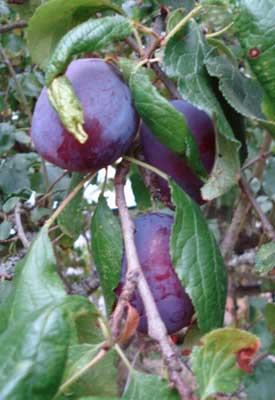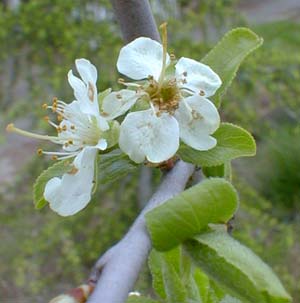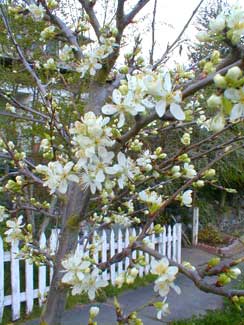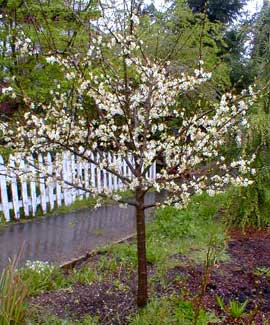
Semi-Dwarf Italian Plum
"Serenity is not something you just find in the world,
like a plum tree, holding up its white petals."
-Mary Oliver,
b.1935
b.1935
I have a sentimental attachment to the common Italian Plum because my great-grandmother Elva had a tiny orchard of these "Prune Trees" as she called them.
They produced such heavy fruit that even after everyone in an extended family had come by to pick boxes full to eat fresh & to can, the ground nevertheless became littered with unpicked, overripe, fallen fruits.
 Elva's trees were old yet small, just the right size to climb up into, sitting on a thick branch with a thirst-quenching lunch dangling fom every branch. All the grandchildren & cousins were welcome to climb about the trees eating our fill, as there was always way more than enough for everyone's needs.
Elva's trees were old yet small, just the right size to climb up into, sitting on a thick branch with a thirst-quenching lunch dangling fom every branch. All the grandchildren & cousins were welcome to climb about the trees eating our fill, as there was always way more than enough for everyone's needs.Granny Artemis & I wanted a no-attention tree for the streetside. We liked best the idea of trees that could even feed us. Of the many possibilities we pondered crabapples, apples, cherries, pears, or plums, besides some mere ornamentals.
Because of my sentimentality toward the Italian Plum, that became a deciding factor, & helped that Granny Artemis's dad was also fond of the same variety & had planted one in his gardened yard in Idaho.
 We obtained one small grafted bareroot, & planted it in a somewhat harsh roadside garden beyond regular watering. It was chosen also for proven hardiness in just such low-maintance areas.
We obtained one small grafted bareroot, & planted it in a somewhat harsh roadside garden beyond regular watering. It was chosen also for proven hardiness in just such low-maintance areas.A year after we planted "Italian Plum" we added a second plum tree to the same area, 'Yellow Egg.' Though it is not necessary that these trees cross-pollinate in order to fruit, I figured it couldn't hurt, & the great thing is there'd eventually be two pleasant-looking trees out there with radically contrasting fruits.
Our tiny trees didn't fruit much until their third year. The fruit photo up top is from September 2008; the fruit were ripening by mid-August, lovely things with yellow pulp & & blue-purple skin with a frosty or dusty waxy coating that easily polishes off.
 Despite that here in the Northwest one can obtain a seed-grown variety called 'Myrobalan,' virtually all pre-spring bareroot offerings are grafted. In the USA the majority of plums are grafted onto tough & hardy Prunus cerasifera rootstock.
Despite that here in the Northwest one can obtain a seed-grown variety called 'Myrobalan,' virtually all pre-spring bareroot offerings are grafted. In the USA the majority of plums are grafted onto tough & hardy Prunus cerasifera rootstock.Ideally plum trees are provided with rich moist loamy soil, but these tough trees flourish even without everything that would be best for them. Though occasional feedings of lime can be beneficial, if the soil becomes alkaline from too much lime, the tree will become sickly & chlorotic.
Once they are fruiting heavily, they require a regular fertilization schedule to continue to fruit well. I'm a great advocate of self-sustaining gardens, returning to the soil everything that some gardeners are prone to clipping out & throwing away. If nothing is permanently removed from a garden, it will call for extremely little fertilizer. But where harvestable fruit is concerned, nutrients are inevitably carted away to be eaten, & the soil has to be maintained with a deciduous-tree fertilizer.
It is amusing to encounter toxic plant lists including warnings for the sake of pets & children, against plants far less toxic than rose-family fruit trees, which are excluded because all everyone thinks about are the tasty fruits. The leaves, bark, seeds or pits of Prunus species are toxic, containing cyanogenic glucosides. The specific toxin amygladin is turned into cyanide in the body. Happily, amygladin levels are too low to be greatly consequential, is even less an issue with domestic versus wild species, thus most botanical prunus species are browsed by ruminants without serious risk.
Yet if someone really were foolish enough to crack open plum pits, pile up the seeds, then eat a great many of them with a smattering of leaves into the bargain & a bark-tea chaser, respiratory failure & death would not be impossible.
European Plums have been in North America for almost as long as there have been Europeans in North America. Spanish missionaries brought them to the west coast, & English colonists brought them to New England. Although there are native plums that also produce edible fruits, nothing compares to the extravagant tastiness & size of the European plum. Perhaps due to discarded pits, the European Plum has naturalized in many temperate areas of the continent, including in the Pacific Northwest & in New England.